This is a Voigtländer Vitessa L, a 35mm rangefinder camera made by Voigtländer AG Braunschweig between the years of 1954 and 1957. This model was an update to the original Vitessa A from 1950 with the addition of an uncoupled selenium light meter and all new LVS (Light Value System) scale. The Vitessa L has several very distinct features including the barn doors that covered the lens and shutter mounted to a bellows unit, and the tall film advance plunger that sticks up above the top plate. The Vitessa series was popular throughout it’s run and was revised several times, ending in a rigid bodied Vitessa T with an interchangeable lens mount. The Vitessa series was below the company’s high end Prominent line, but above the Vito.
Film Type: 135 (35mm)
Lens: 50mm f/2 Voigtländer Ultron coated 6-elements
Focus: 2.6 feet to Infinity with Click Stops for Portrait, Group, and Scenery
Viewfinder: Coincident Image Coupled Rangefinder
Shutter: Synchro-Compur Leaf
Speeds: B, 1 – 1/500 seconds
Exposure Meter: Coupled Selenium Cell w/ top plate LVS readout
Battery: None
Flash Mount: Coldshoe and PC M and X Flash Sync
Weight: 694 grams
Manual (similar model): http://www.cameramanuals.org/voigtlander_pdf/voigtlander_vitessa_n.pdf
Manual (exposure meter only): http://www.cameramanuals.org/voigtlander_pdf/vintessa_exposure_meter.pdf
How these ratings work |
The Voigtländer Vitessa is perhaps one of the most unique 35mm cameras ever made. With nearly every feature having some strange quirk or design element not often found in other cameras, this model definitely requires a quick look through the user manual before shooting. But therein lies the charm. Many of the oddball controls actually work really well, and like most other Voigtländer cameras, has outstanding lenses which make them extremely capable shooters. I didn’t love everything about this camera, but there was certainly enough to make it interesting, memorable, and fun. Even if you never decide to add one to your collection, I recommend borrowing one and giving it a shot. | ||||||
| Images | Handling | Features | Viewfinder | Feel & Beauty | History | Age | |
| 2 | 1 | 1 | 1 | 2 | 1 | 30% | |
| Bonus | none | ||||||
| Final Score | 10.4 | ||||||
History
After World War II, the landscape of the camera industry would take a dramatic turn. German companies, who were once the pinnacle of the entire industry were suddenly cut off from the rest of the world due to political and infrastructure changes, and also due to damages sustained in the war. Many of Germany’s top companies were based in the Dresden area, which was heavily damaged by Allied forces, and after the war, controlled by the Soviet government.

Companies like Voigtländer who were based in what would become West Germany, and didn’t sustain as much damage, had a greater ability to resume research and production of new products. Voigtländer, being Germany’s oldest optics company, and one that had already built a range of quality cameras before the war, started working on several new models immediately following the war. Their prewar entry level 35mm camera, the Vito, was upgraded and released as the Vito II. A top of the line rangefinder designed with the professional photographer in mind with features like an interchangeable lens mount called the Prominent was released, and for those looking for something in between those two models, an all new creation called the Vitessa was created.
I’ve previously covered my thoughts on how Voigtländer never followed established norms both in design and function, so I’ll attempt to not repeat myself too much, but I would like to have been a fly on the wall in the Research and Development department while the Vitessa was being created. Who made the decisions to design the camera in the way it was designed? Was it a designer or an engineer?
Here’s my interpretation of how I imagine that discussion might have went:
- Designer: Okay team, we need to come up with a mid range 35mm rangefinder to compete with cameras like the Kodak Retina series. All we know is that it must use 35mm film, have a rangefinder, and use our best lenses.
- Engineer: Well, if it’s going to compete with the Retina, should it be a folding camera?
- Designer: Of course it needs to fold!
- Engineer: Okay, should the folding door have a left side hinge, or a right side hinge?
- Designer: We’re Germans, why have one hinge, when we can have two?! Lets make it fold on both sides!
- Engineer: Okay, barn doors. Got it. Won’t that make adjusting things like focus on the lens a little tricky if there is a door on both sides blocking the photographer’s hand?
- Designer: Good point. Why don’t we make the focus control on the rear of the camera. We could build a complicated set of gears with a depth of field wheel on top of the camera that controls the helical inside of the camera, but from the back!
- Engineer: Uuuh ok, that’s going to be a lot of work, but I think we can manage it, as long as we don’t complicate too much else. What about film advance? Should we keep it on top of the camera, or the bottom like the Retina?
- Designer: Of course the top, putting the film advance on the bottom of a camera is stupid!
- Engineer: Phew! That’s a relie…
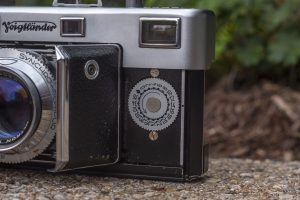 Designer: …but instead of a traditional lever like everyone else, what if we construct a large pole that sticks high above the top plate of the camera that the photographer must contort their hand to press down to both advance the film and set the shutter?
Designer: …but instead of a traditional lever like everyone else, what if we construct a large pole that sticks high above the top plate of the camera that the photographer must contort their hand to press down to both advance the film and set the shutter?- Engineer: …uuuuhhh…
- Designer: …and then we’ll make the exposure counter on the front of the camera, completely inaccessible by the user unless you remove the back and the bottom of the camera.
- Designer 2: Sir, why stop there? What if the front of the camera also came off with the back and the bottom unnecessarily exposing large parts of the insides of the camera to dust, debris, and moisture?
- Designer 1: That’s a great idea Klaus! You deserve a raise, and a schnitzel!
- Designer 2: Hey, where’d the engineer go?
In all seriousness, the Vitessa is a remarkable achievement in engineering. Despite the many design quirks of the camera, it proved to be a popular enough model to stay in production for a decade and receive several upgrades along the way.
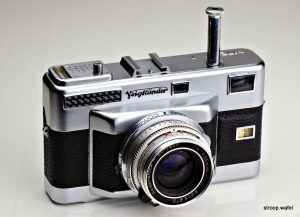
The earliest models, known today as the Vitessa A, lacked many of the features found in later models like an accessory shoe, automatic parallax correction, self-timer, or strap lugs. In 1954, a revised model known as the Vitessa L debuted with an uncoupled selenium exposure meter and Light Value Scale system on the shutter (that’s what the “L” in “Vitessa L” stood for). Finally in 1957, came a rigid bodied model called the Vitessa T that lost the folding front doors of the earlier models, but replaced it with an interchangeable lens mount that allowed it to use Vitessa specific DKL lenses. Strangely, at the same time of it’s release, Voigtländer also had the Bessamatic SLR that also used DKL lenses, but they were not interchangeable with the Vitessa.

The Vitessa L sold in 1954 for $159.50 with the Ultron 50/2 lens, $139.50 with the Color-Skopar 50/2.8 lens, and $99.50 with the Color-Skopar 50/3.5 lens. The leather “Ever-Ready” case was an additional $10.50. These prices compare to $1500, $1310, and $935 today and were cheaper than the Kodak Retina IIIc with 50/2 Schneider-Retina Xenon lens at $175. As was the case with most Voigtländer models, a list of accessories including hoods, filters, cases, flash units, and even a Proximeter (for close focus) were available. Click here for a sales catalog for the earlier Vitessa A showing some of the accessories available at the time.
There is no way to know how well these cameras sold, but for them to have stayed in production for 10 years, and show up on used sites like eBay as regularly as they do, my guess is they sold “well enough”. Period reviews like the ones below were quite positive, proclaiming the camera’s LVS system as “revolutionary”, and go on to say that it is a “darn good camera with a fast lens, rapid shooting, and good construction”.
The gallery below shows two different articles from the February 1955 issue of Popular Photography and the June 1956 issue of Modern Photography along with a page from a Voigtländer sales catalog showing how the camera was marketed. Click on each image for a full size view.
Today, the Vitessa, like most Voigtländers is highly collectible. It’s quality lenses and shutters make them very capable shooters, the quirky controls make for a memorable shooting experience, and for those who just like to display their collection, they look great on a shelf. As I write this, there are about 120 of them for sale on eBay and sold prices vary from about $50 for a parts camera to $200 for a good working model with the Ultron making them a pretty good bargain for such a capable and unique camera. Whether it’s something you plan on shooting or just admiring, this is definitely a camera with something for everyone.
My Thoughts

It’s hard to believe, but more than 4 years have passed since my first camera review on my site, and in that time, I’ve experienced many unexpected benefits. From a behind the scenes tour of a 118 year old camera shop, to visiting the personal collection of the president of the Nikon Historical Society, and meeting countless awesome collectors and other camera enthusiasts, to all of the awesome feedback I’ve received from the readers of my site, it has been a really fun journey, and one I hope to continue for many years to come.
Perhaps the best benefit however, are the incredibly generous people who have contacted me with offers to take donations of cameras for future reviews. I’ve received Miranda SLRs, Argus box cameras, Rolleiflexes, and recently, a Voigtländer Vitessa L. I was first contacted by a French reader who wished to remain anonymous and he asked if I was interested in Voigtländers but wouldn’t specify which model. I struck up a conversation with the guy and he agreed to send something to me to keep for a future review. He wanted to keep the identity a surprise, so after a couple of weeks waiting for the international package to arrive, I opened it up to discover this beautiful camera in perfect working condition.
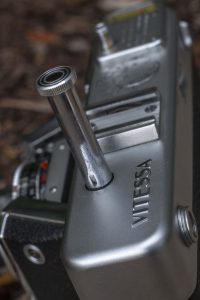
The Vitessa has been a model on my radar since the very early days of collecting. It’s “barn door” style, rear thumb wheel focus, and strange “antenna-like” film advance plunger make for an intriguing camera. I’ve always been drawn to cameras that do things a little bit differently than others, so the Vitessa was right up my alley.
The Vitessa is a folding bellows camera, which in theory means it likely competed against cameras like the Kodak Retina II and III series from the 1950s, but the main body of the camera is quite a bit larger than a Retina. It compares in height and width to full size rangefinders of the 1960s and 70s like the Yashica Electro and Minolta Hi-Matic 7, but when folded, easily fits into a large pocket.
It’s not a lightweight camera. Built in the middle of the 1950s prior to the widespread use of plastic and other weight saving materials, the camera weighs 694 grams without film. Of course since it was built prior to the widespread use of plastic and other weight (and cost) saving materials, the camera is also very solid and feels wonderful in your hands. Even with the lens extended, there is no wobble or play when handling the camera. The lens and shutter extend and retract with a satisfying motion with clearly defined limits. While it’s really not fair to keep comparing the Vitessa to the Retina, I’ll say that both are perfect examples of the quality craftsmanship associated with German cameras from the 1950s.

The top of the camera features perhaps the strangest feature of any camera I’ve ever seen, which is the large antenna like plunger that simultaneously advances the film, sets the shutter, and increases the exposure counter. Does it work? Yes, it works, but boy, Voigtländer really went out on a limb here with this one. Now, to be fair, other companies got a bit creative with their film advance too. Konishiroku had the left thumb advance on the Konica III, and of course many companies like Riken, Canon, and Leitz released models with bottom trigger wind levers, but I don’t think there has ever been a camera with a large plunger sticking straight up out of the camera like this. The Vitessa manual suggests using the index finger on your left hand to push down on it, but that requires quite a stretch of your hand. People with small hands or stubby fingers likely would have struggled with this. With the lens and shutter erect, the plunger is always sticking up like you usually see it in pics, but with the camera closed, you can push the plunger down and it will stay down. Pushing the plunger down with the camera closed will not advance the film. This is a welcome feature as there would be no easy way to stick this thing in your pocket or a small case with it protruding up like that.
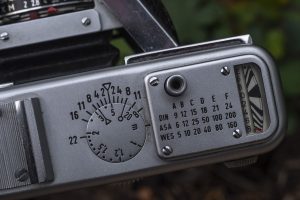
To the right of the film advance is an accessory shoe, a rotating depth of field scale, threaded shutter release (which also doubles as the front door release with the camera closed), and top readout for the exposure meter. The depth of field scale here is directly linked to the thumb wheel focus dial on the back of the camera, and fundamentally works the same as any other depth of field scale, except rather than being on the lens, is on the top plate. In the image to the left, the camera is set at 5 meters, and shows that at f/8 everything from roughly 3.5m to 15m will be in focus. The exposure meter has a chart that somewhat resembles a calendar that acts as a sort of conversion table for different film speeds. Voigtländer clearly wanted to appeal to as many people as possible by showing film speeds on the ASA, DIN, and Weston film scales. Although ASA and DIN readouts are not unusual on 1950s cameras, I don’t think I’ve ever seen another camera with Weston speeds. Although the exposure meter on this camera seemed to work fine, I found it complicated to use, so I ignored it and shot the entire roll using Sunny 16.
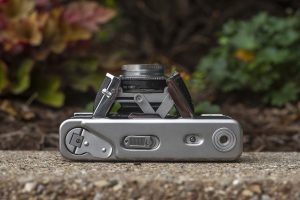
On the bottom of the camera, from left to right is the flip out rewind lever. There is no release for this lever, you simply fold it down and rotate it to rewind the camera. In the very center of the rewind lever is a small circular shaft with a red line through it. This shaft and red line will rotate as your film is advancing and is the only way to know if your film is transporting (or rewinding) correctly. In the center is the rear film door release. Contrary to how it looks, it does not slide, but rather folds out 90 degrees. With it folded out, you rotate it 90 degrees in either direction to release the door lock. With the lock released, you pull down using this lever to remove the entire back and bottom of the camera. To it’s right is the rewind release button and 1/4″ tripod socket.
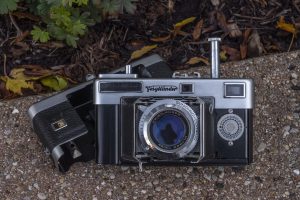
Like many cameras of the mid 20th century, the bottom of the Vitessa and the back are one piece, but unlike many cameras of the mid 20th century, parts of the front of the camera are also part of the back, so when loading the camera, you are essentially pulling the camera out of an exterior shell.
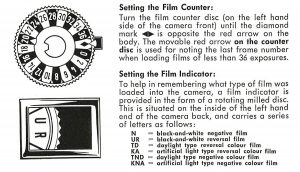
Doing so precariously exposes the entire exposure counter, showing it’s entire range from 0 – 36. With the counter exposed like this, manually turning it back to 0 (actually the little diamond) is the only way to reset the exposure counter. Staying within the window of the front of the camera, is a sort of film reminder with cryptic letters like KA, TD, UR, NN, and a few others. Like the exposure counter, the only way to change this is with the camera front off. The Vitessa’s user manually thankfully decodes what these letters mean. Who would have guessed that UR means “black and white reversal film”?!
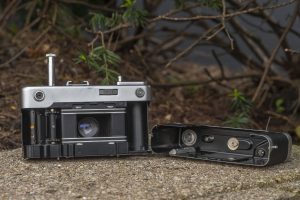
Film travels in the Vitessa from right to left, so apart from it being backwards of most 35mm cameras of the era, I found attaching the film leader strangely difficult. There is a large opening on the fixed take up spool to which you shove the tip of the film leader into. My problem was that the camera didn’t want to securely grip the leader as there is no “hook” to catch a perforation like on many cameras. I had trouble with the leader falling out when trying to reattach the back to the camera. Once you do have it secured, your film cassette goes into the cavity on the right.
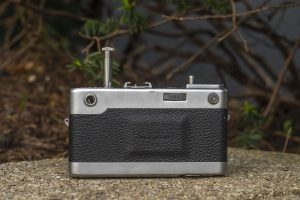
The back of the camera has a prominent hump for the film pressure plate and features the rear eyepiece, the thumb wheel for focus control and a rotating knob which changes a set of light value numbers within the top readout for the exposure meter which you are supposed to set according to whichever film speed you have installed in the camera. As I mentioned earlier, I found the exposure meter to be overly complicated, so I didn’t use it.
Although I didn’t capture an image through the viewfinder of this camera, the viewfinder is sufficiently big and even with prescription glasses was large enough for me to see most of the 50mm frame. The coincident image rangefinder patch is square and had enough contrast to work in all but the darkest scenes.

With the lens and shutter in the open position, the Vitessa makes it’s strongest resemblance to the Kodak Retina. Kodak’s mid 50s Retinas share a very similar Synchro-Compur leaf shutter with same range of shutter speeds, self timer, flash sync, and infuriating Light Value Scale (LVS) system. I’ve spoken in many reviews before about my disdain for most LVS systems on cameras of the mid 20th century. I completely understand what they were designed to accomplish and in the right circumstances, can be quite useful, but my issue is simply the lack of finesse needed to override a setting. With a folding camera like the Vitessa or Retina, you have to weave your finger into a cramped location to move a little pin to a different number if your lighting changes while shooting. Every time I say this, someone usually sends me an email or makes a comment that I don’t understand how the system works. I do understand, I just don’t like it. Making matters worse, other companies like Ricoh and Minolta have cameras with LVS systems that are easy to override. I never let the system here ruin my shooting experience, but I just wish there was a better way to bypass it.
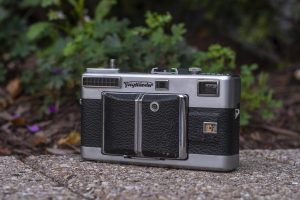
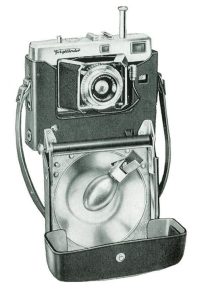
Otherwise, the setting of shutter speeds and f/stops is like most other leaf shutter cameras. For those who need to use flash, the Vitessa conveniently locates the PC sync port on the front of one of the barn doors, as opposed to the side of the shutter, like on the Kodak Retina. Although the flash socket works with any flash unit of the era, there was also an interesting Vitessa “flash case” for $29.50 that contained a battery pack and flashbulb unit in the case itself.
Lastly, when it’s time to close the camera, equal pressure on the top and bottom of the front of the shutter will simultaneously collapse the bellows and close the doors. There are quarter-circle marks on the shutter at the 12 and 6 o’clock positions as a reminder of where to press.
It doesn’t take a long review like this one to tell you the Voigtländer Vitessa is a quirky camera. Whether it’s the front barn doors, the large film advance plunger, or the rear focus thumb wheel, this is one of the oddest cameras ever made, yet somehow, it all comes together quite nicely. Despite it’s larger size than a Kodak Retina which was it’s most logical competitor, the Vitessa is quite portable. When folded up, the camera does fit into a coat pocket or even a front shirt pocket. It’s weight will never let you forget it’s there, but for short journeys, it maintains a portable form factor. I was a bit critical of the Voigtländer Prominent in that camera’s review, but how does the Vitessa compare?
My Results
Unlike many cameras that I review where I don’t know the shooting condition of the camera prior to it’s first roll, the previous owner of the Vitessa assured me this camera was film tested and that everything worked correctly. Even without this assurance, the Vitessa was in wonderful shape, so I felt like I could be a little more ambitious with my first roll, so I loaded up a fresh roll of Kodak Portra 160 and took it with me on a fall excursion to a pumpkin farm near Minooka, Illinois.
Putting aside all of the strange quirks of the Vitessa, the camera makes spectacular shots. Of course the 6-element Ultron deserves a lot of that credit, but I’ve seen other cameras like the Kodak Bantam Special that have high-spec lenses but delivered lackluster results, so a good lens is not a guarantee of great pics.
I’ll probably take some heat for this, as I was rather hard on the Voigtländer Prominent for it’s poorly executed “focus wheel where the rewind knob should be”, but I really enjoyed the shooting experience with the Vitessa. For one, the rear thumb wheel for focus works really well. I found that while holding the camera, my thumb naturally rested on that wheel anyway, so there was no requirement to reposition my hand to adjust focus. Fujica would borrow this same feature for a variety of their late 50s and early 60s rangefinders like the Fujica 35-ML.
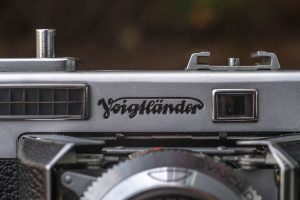
Yes, the film advance plunger is strange, but it is something you don’t need to do “in the moment”. I find that strange controls quirks are more easily forgiven if they can be done separate from the act of shooting photos. The Vitessa has a lot to like about it, and my biggest complaint is really the LVS scale that bothers me on nearly every other camera that has a similar system. I burned through the 36-exposure roll of Portra 160 quickly. I shot it indoors, outdoors, I shot close-ups of my kids, faraway landscapes, and everything in between, and with only a few exceptions, got an entire roll of wonderfully sharp images.
I’d even go as far to say that these images have an almost “digital-like” sharpness to them and had it not been for the muted color palette often associated with Portra films, these pics very well could have been from a digital camera. Although this Vitessa doesn’t have interchangeable lenses, the Ultron formula is one that is still sold today in lens mounts for modern digital cameras.
The Vitessa is a unique camera for sure, but is it perfect? No. For a mid 50s 35mm rangefinder, there are smaller and easier cameras to use that won’t require a refresher of the user’s manual each time you pick it up, but you could also do a lot worse. Unlike other mid-century quirky rangefinders like the Konica III and Voigtländer Prominent that have a few features that get in the way of the shooting experience, the Vitessa is quite a lot of fun to use and for it’s size, is still quite portable.
Thank you to my anonymous French reader for the kind donation of this camera. This is a model that had continued to elude me over the years, and one that even if I were to pull the trigger on, likely wouldn’t have been in this good of shape, or came with the excellent Ultron lens!
Additional Resources
http://camera-wiki.org/wiki/Vitessa
https://www.cameraquest.com/voitvitl.htm
http://www.cjs-classic-cameras.co.uk/voigtlander/voigt.html#vitessa
http://thevisualexperiment.blogspot.com/2015/12/camera-review-voigtlander-vitessa.html
http://corsopolaris.net/supercameras/vitessa/vitessaeng.html
http://voigtlander.pagesperso-orange.fr/anglais/vitessatousA.htm
https://www.lausch41.com/vitessa.htm (in German)
http://www.voigtlaendersammlung.de/html/uebersicht.html (in German)
https://www.rangefinderforum.com/forums/showthread.php?t=159524

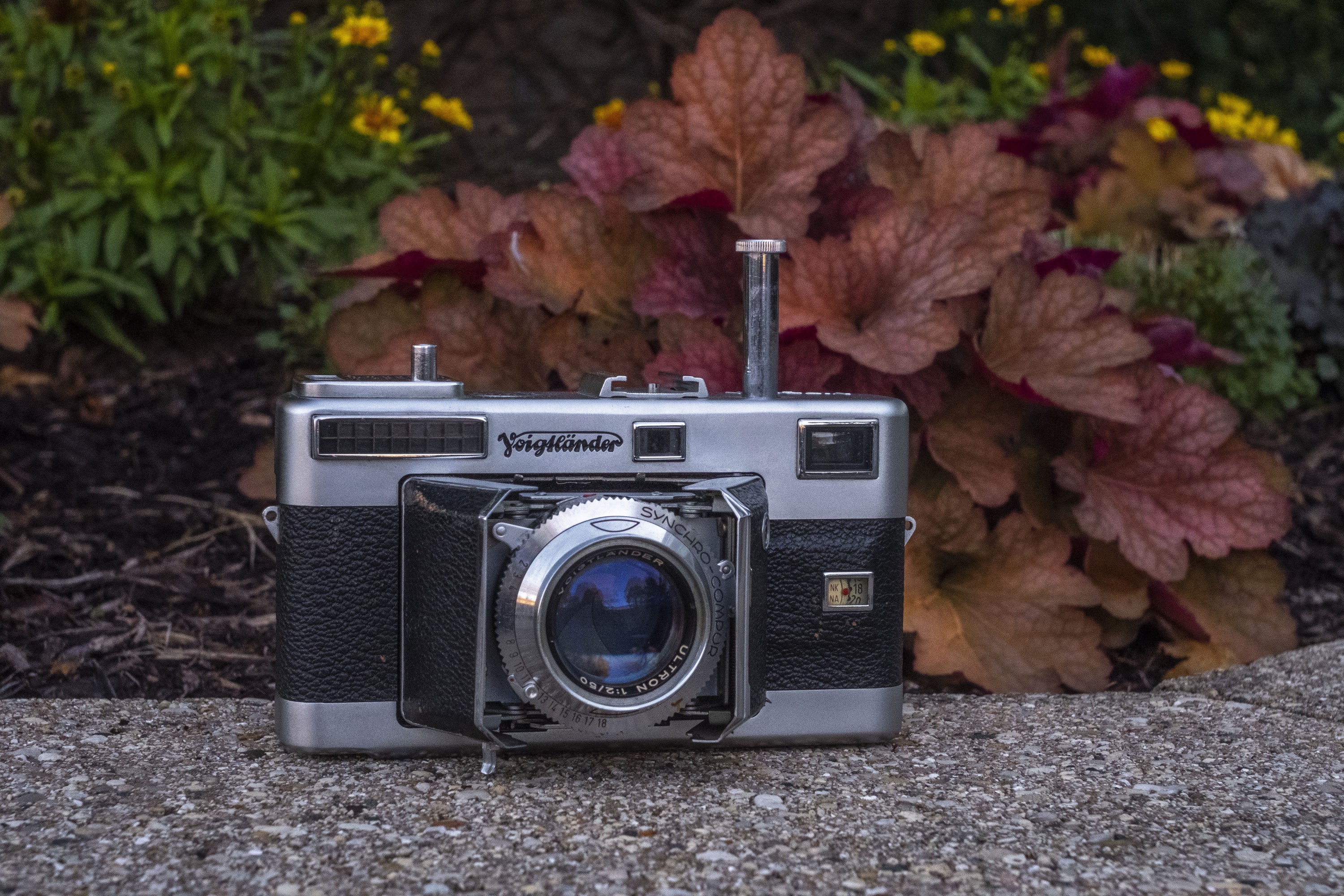
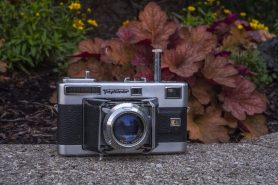
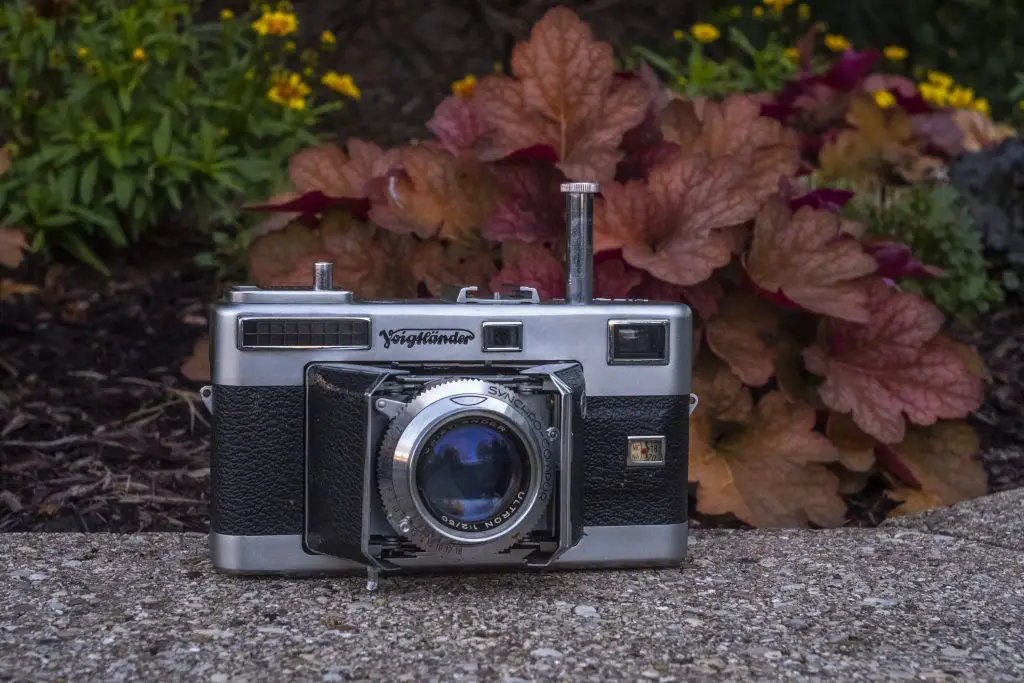
















I have hundreds of cameras in my collection. My Vitessa is one of my favorites. Thank you for a most enjoyable article, with great information and insight!
Thanks for this article and for your site! I recently purchased an early model A Vitessa and the shutter is in need of a cleaning — blades are sticking. And relatedly I think, when you cock the shutter it has to be done slowly and deliberately in order for the cocking lever to move fully to 3 o’clock. Otherwise, it slips.
I’d like to clean the shutter but I’m not sure how to get to it. Any tips? It seems the front lens element would unscrew but I can’t get it to budge.
Thanks! You’ve been my kitchen table repair inspiration.
Peter, thanks for the kind words! I am happy you’ve enjoyed my site.
I am sorry though that I cannot offer you any advice for repairing your Vitessa. While I am normally very willing to open up a large number of old cameras, there are just some that I won’t touch, and Voigtländers are one kind. There’s an old saying that if a job could be accomplished with 12 parts, the Germans would use 24, and that’s the case with these. A simple job like a shutter flush could very easily turn into a disaster. These are very nice cameras that are worth the price to send them off to a professional. That’s what I would do if I was in your situation.
Thanks for the quick reply and advice, Mike. Can you suggest some repair shops I might contact here in the US? I found a semi-retired Voigtlander- trained repairman in Germany but would prefer not to ship it internationally if I can avoid it.
Really enjoyed your article!
I know it has been a while since it was posted but I think I know what the cryptic abbreviations for the film type mean and I want to share my thoughts: The first letter is the first letter of the German word while the second is the first letter of the English word for that type of film. Meaning that UR Means Umkehr/Reversal, TD is Tageslicht/Daylight, KA is Kunstlicht/Artificial light and the ones with an N in between just mean that it is negative film.